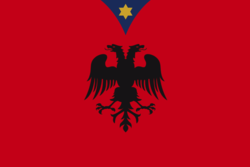| Part of a series on |
| Albanians |
|---|
 |
| By country |
|
| Culture |
| Religion |
| Languages and dialects |
| History of Albania |
|---|
 |
| Timeline |
The Albanians (Albanian: Shqiptarët) and their country Albania (Shqipëria) have been identified by many ethnonyms. The native endonym is Shqiptar. The name "Albanians" Latin: Albanenses/Arbanenses) was used in medieval Greek and Latin documents that gradually entered European languages from which other similar derivative names emerged.[1] Linguists believe that the alb part in the root word originates from an Indo-European term for a type of mountainous topography, meaning "hill, mountain", also present in Alps.[2] Through the root word alban and its rhotacized equivalents arban, albar, and arbar, the term in Albanian became rendered as Arbëreshë (Gheg Albanian: Arbëneshë) for the people and Arbëria (Gheg Albanian: Arbënia) for the country.[1][3]
Contemporary Albanian language employs a different ethnonym, with modern Albanians referring to themselves as Shqiptarë and to their country as Shqipëria.[3] Two etymologies have been proposed for this ethnonym: one, derived the name from the Albanian word for eagle (shqiponjë).[4] The eagle was a common heraldic symbol for many Albanian dynasties in the Late Middle Ages and came to be a symbol of the Albanians in general, for example the flag of Skanderbeg, whose family symbol was the black double-headed eagle, as displayed on the Albanian flag.[5][6][7][8][4] The other within scholarship connects it to the verb 'pronounce' (shqiptoj), deriving from Latin excipere. In this instance the Albanian endonym like many others would originally have been a term connoting "those who speak [intelligibly, the same language]".[4] Attested from 14th century onward, the placename Shqipëria and the ethnic demonym Shqiptarë gradually replaced Arbëria and Arbëreshë amongst Albanian speakers between the late 17th and early 18th centuries.[3][9] That era brought about religious and other sociopolitical changes.[3] As such a new and generalised response by Albanians based on ethnic and linguistic consciousness to this new and different Ottoman world emerging around them was a change in ethnonym.[3]
- ^ a b Cite error: The named reference
Elsie200534was invoked but never defined (see the help page). - ^ Cite error: The named reference
Malcolm29was invoked but never defined (see the help page). - ^ a b c d e Cite error: The named reference
Lloshi277was invoked but never defined (see the help page). - ^ a b c Cite error: The named reference
Kamusella241was invoked but never defined (see the help page). - ^ Elsie 2010, "Flag, Albanian", p. 140: "The eagle was a common heraldic symbol for many Albanian dynasties in the Late Middle Ages and came to be a symbol of the Albanians in general. It is also said to have been the flag of Skanderbeg...As a symbol of modern Albania, the flag began to be seen during the years of the national awakening and was in common use during the uprisings of 1909-1912. It was this flag that Ismail Qemal bey Vlora raised in Vlora on 28 November 1912 in proclaiming Albanian independence."
- ^ The Flag Bulletin. Flag Research Center. 1987-01-01.
History records that the 15th century Albanian national hero, Skanderbeg (i.e. George Kastriota), had raised the red flag with the black eagle over his ancestral home, the Fortress of Kruje
- ^ Hodgkison, Harry (2005). Scanderbeg: From Ottoman Captive to Albanian Hero. Bloomsbury Academic. ISBN 978-1-85043-941-7.
- ^ "ALBANCI". Enciklopedija Jugoslavije 2nd ed. Vol. Supplement. Zagreb: JLZ. 1984. p. 1.
- ^ Cite error: The named reference
Matasovićwas invoked but never defined (see the help page).
© MMXXIII Rich X Search. We shall prevail. All rights reserved. Rich X Search
